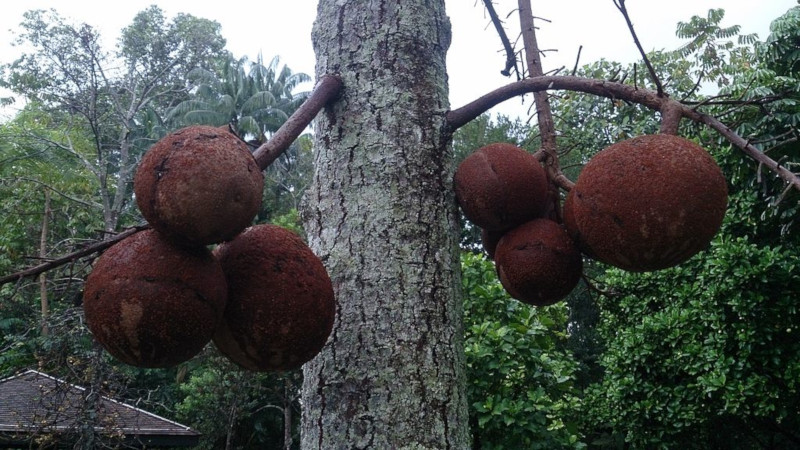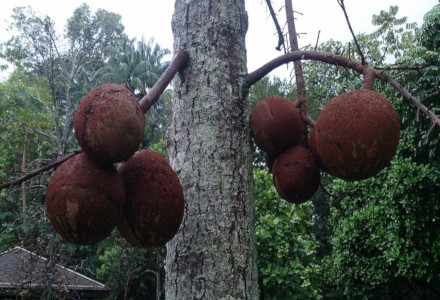
Cannonball Tree Facts
- Quite amazingly, the attention-grabbing term of Cannonball Tree serves as the common name for the Couroupita guianensis. This truly awesome tree quite clearly stands out. It also represents a highly distinctive tree native to only a specific portion of the world.
- This remarkable and fascinating species, however, now exists in cultivation in many regions of the world possessing an appropriate climate. While its fruit remains completely edible, humans rarely eat the surprising plant. The reason may surprise you.
- That’s due to an unexpected trait. That’s the fact that, despite the quite fragrant appeal of its flowers, many consider the fruit itself to have a distinctly unpleasant aroma. But the enormous fruit of the tree does have commercial value, at least of a sort.
- That’s because, and somewhat surprisingly so, many local inhabitants of its region actually feed it to their livestock. The marvelous Cannonball Tree nevertheless has long held a role of importance. This manifests in the cultures of local Indigenous Peoples.
- These local inhabitants have also long used it as a source of medicines. There, it’s used to treat a wide variety of complaints. These include treating such conditions as skin conditions, injuries, malaria, and even toothaches and the common cold.
- In many countries, though, it now forms a remarkably popular ornamental plant. This only increases concerns for it. Fortunately for those who appreciate the wonders of Nature, this tree appears to be maintaining a stable population, for the moment.
- The IUCN, therefore, currently lists it as Least Concern on its Red List of Threatened Species. It nevertheless does face threats to its continued existence. Most currently, it faces the danger of habitat loss. Plus, the tree also faces the ongoing threat of climate change.
Related Articles
Cannonball Tree Physical Description
In addition to its other unique characteristics, the truly fascinating Cannonball Tree also constitutes a reasonably large variety of tree. That’s due to the impressive fact that this particular species of plant typically attains heights equaling around 110 ft (35 m).
The majority of specimens growing outside of its native region, however, most commonly average slightly less in height. Its other features more than make up for this in terms of appeal, though. For one, its leaves generally develop in comparatively large clusters.
These groupings develop on the end of short branches. Those branches typically grow to a length measuring between 3 – 12 in (8 – 31 cm) in length. These can further grow to as long as 22 in (57 cm) in overall length. The flowers produced also have an extremely strong aroma.
Yet, for all their glory, these aren’t the most wonderful feature of this awesome flora. In fact, its astonishing fruit remains the feature for which the fabulous Cannonball Tree is best known. That holds true due to the existence of the amazing physical nature of these.
Firstly, this impressive fruit attains an average mature size of roughly 10 in (25 cm) in diameter. This, understandably, serves as the source of the common name of he tree. Secondly, just one of these astounding fruits may hold as many as 550 seeds.
- Kingdom: Plantae
- Phylum: Angiosperm
- Class: Eudicots
- Order: Ericales
- Family: Lecythidaceae
- Genus: Couroupita
- Species: C. guianensis
Cannonball Tree Distribution, Habitat, and Ecology
The amazing Cannonball Tree evolved as native to a region already well known for supporting a rich diversity of flora. In point of fact, this amazing tree evolved as endemic to the breathtaking region consisting of portions of Central America and South America.
Understandably, it thrives in a tropical climate, sharing its habitat with related species, such as the Brazil nut. It also shares some traits with other types of local flora. The tree achieves its pollination via the activities of various species of bee endemic to its region.
These include such varieties as bumblebees, wasps, and flower flies, to name a few. Carpenter bees, however, appear to be a primary pollinator of this truly remarkable tree. All this action occurs despite the astounding fact that the tree produces no nectar.
The fascinating Cannonball Tree also remains entirely dependent upon local wildlife for its propagation. In point of fact, its many seeds become dispersed by different animals that feed on the fruits of the plant. It has no other means of maintaining its numbers.
When these seeds fall to the ground, the tough outer shell breaks open. This then, obviously, reveals the fruit within. Animals such as domestic pigs and chickens, among others, consume the fruit voraciously. Consequently, these later spread the seeds via droppings.
Species Sharing Its Range
Check out our other articles on Earth’s Many Mesmerizing Cephalopods, Crowned Eagle, Regal Birdflower, Green Dragontail, Indian Giant Squirrel, Orange Oakleaf, Aldabra Giant Tortoise

